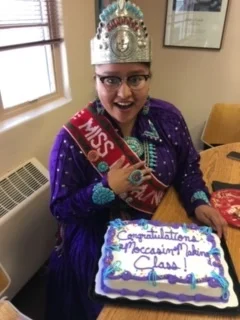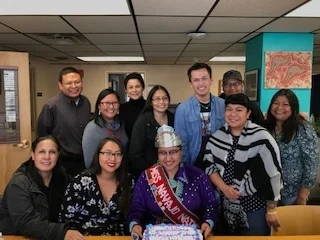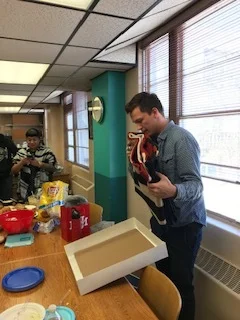Diné Moccasin Making Workshop
Funded by First Nations development INstitute - Native Youth and Culture Grant
Helping Us Inspire a New Generation of Cultural Knowledge Holders
The Diné Studies Conference, Inc. hosted a four-day workshop taught by Mr. Sam Slater, a Diné moccasin maker from Round Rock, Arizona.
This workshop was very unique. We initially imagined the grant focused on bridging elders to youth. Instead, we discovered that there were many young people that retained the position of cultural knowledge holders, a term coined by James McKenzie. It was this recognition of young cultural knowledge holders that we discovered individuals like Sam Slater and the former Miss Navajo, Crystal Littleben. These individuals are our leaders as they work everyday to retain and apply cultural skills and historical understandings to our new generation of Diné youth. For this workshop, we invited Mr. Sam Slater, a graduate of the Navajo Cultural Arts Program at Dine’ College and now, an undergraduate at Columbia University. He unified the intellectual and cultural talents necessary to provide this course to our youth.
Overview
The students were taught the foundational skills of making kélchí, Navajo low-cut moccasins, by completing a miniature version and their own personal pair. Students also learned the philosophies inherent in moccasin making and wearing. The lessons included historical and cultural stories that have shaped the contemporary role of moccasins in Diné society. Students gained a greater level of consciousness surrounding the production and use of our traditional Navajo arts and the way of life they dictate. Students learned that moccasin wearing is a crucial part of strengthening their self-image and moccasin making as an important piece of striving toward a life of holistic Navajo wellness. Class discussions also explored the ways moccasin teachings can challenge and/or put into practice contemporary discourses of decolonization and indigenization.
Telling Their storY
During the course of the moccasin making workshop, youth were asked to end each day with a journal. As students progressed through each day, they were asked questions to reflect on their experience. Mr. Sam Slater reflects on the moccasin making workshop and the the pedagogy guiding his teaching. Youth share their experience through their journal.
Day 1 Reflections:
I’m excited to make my own pair of moccasins because I’ve never owned a pair of my own. This is something unique and different for me.
I am nervous about this process. I don’t know if the moccasin will come out the correct size. I think during the process the strengths will have to come from within the maker of the moccasin. It will take time to work on the moccasin using patience and your mind and the basics of using your hands for this process. It is very rare to get a chance to be taught the moccasin making.
Day 2 Reflections:
I feel I do have my own moccasin story. I had not owned my own pair until I was in high school, but would borrow some from sisters or aunts; although they say you’re not suppose to. Nonetheless my gradual emergence into my Diné culture and teachings is represented by getting to own a pair of my own.
I think that moccasins hold what is within the individual, very sacred is within the individual, very sacred power to some. If I have a moccasin story, I tell it but I don’t. I never owned a pair and not many of my family members own this sacred tradition. After I take the time to reflect on what I learned about moccasins, I sure will pass on the knowledge I have learned.
Day 3 Reflections:
I feel like this whole experience has been so fantastic! Even though I struggled a bit and had to start over a few times, it was well worth it in the end. I’m happy with the finished product. So what I think this give me int he future is persistence because it took a lot of self strength and determination to finish my pair of moccasins which will help me a lot down the road.
I related my moccasins to my mother as I remember my mom chasing after her livestock back to the corral. Also, she would be proud to wear her moccasins to traditional events. We, as a family, had the privilege to partake in dances so we the women and men would wear our own moccasins and dress traditional. I believe my parents would be happy and proud that I made my own moccasins.





























